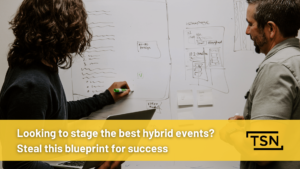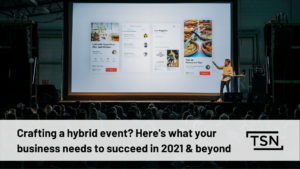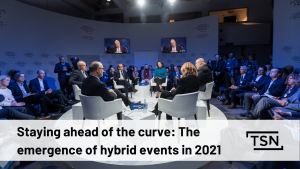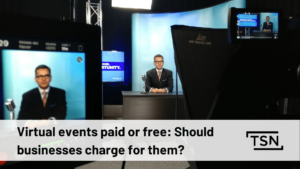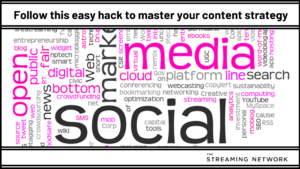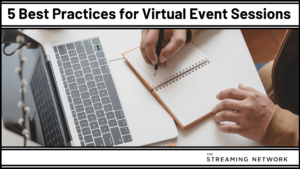As Covid-19 restrictions continue to lift, the world of business is emerging a changed place. Gone are the old, rigid workplace dynamics and traditional means of putting on events, replaced by a fluid system that empowers workforces and audiences.
The proof is in the pudding.
A recent McKinsey survey suggests that 90 per cent of organizations will adopt some combination of remote and on-site work. Event organizers and leadership teams pivoted too and have spent the past year learning the ins and outs of running great virtual conferences and leveraging advanced virtual event platforms.
But there are more changes on the horizon, especially in the live event industry. Faced with new realities – a renewed emphasis on health and safety, uncertainty over travel restrictions as well as rapid acceleration towards a digital future – perceptive organizations are increasingly turning to the hybrid event model.
Hybrid events offer an attractive middle ground to reaching our goals and objectives, in this so called “new normal.” The problem is that hosting one of these can be infinitely more complex than just meeting in-person or virtually. Without a solid grasp of the differences, there are so many little things that can unravel your efforts and prevent you from fully succeeding.
There is, however, a solution.
The experts at The Streaming Network have pooled their knowledge together to break down the core elements of a hybrid event as well as highlight examples of hybrid events done right. Follow this ‘blueprint’ and you’ll be well on your way to making a seamless transition from virtual to hybrid events.
Difference between hybrid, in-person & virtual events
When you’re crafting your hybrid experiences, it’s important to understand that you cannot treat it exactly like a virtual or physical event. It a successful hybrid event stands alone.
In-person events, as the name implies, are a live gathering where content and interactions are handled face-to-face. Conversely, during virtual events, individuals experience the event and its content online; businesses have the ability to collect and track a rich set of data points.
Combining the best of each of these, hybrid events are a mixture of in-person attendees and remote meeting participants, with their own set of engagement tools. The problem is that it can be tricky to prepare and coordinate for one, as you need to make the experience engaging and rewarding for a larger audience. After more than a year of being the sole focal point, virtual attendees will not take kindly to being neglected in favour of your physical audience.
Types of hybrid events
The hybrid event format is suitable for many different types of meetings and programs, whether it’s trade shows and conferences or product launches and team meetings. However, there are also many different hybrid structures that fit different needs and demands. Your options are as follows:
- Traditional hybrid aka “The big company play”
- Reverse hybrid aka “Looks like a traditional hybrid event but it’s not”
- The multi-venue approach
- The non-hybrid/hybrid event
If you’re curious to learn more and how you can incorporate one of these into your efforts, we’ve recently put together a detailed breakdown on each of these hybrid options .
Benefits of going hybrid
Once you go hybrid, you may never want to go back. Why? Because hybrid events take all the inherent advantages of physical and virtual events and roll it up into one comprehensive package. Done correctly, at the very least, you’ll see greater attendance and higher engagement levels.
Here are a few more benefits:
Expanded reach
People love the freedom of choice (or at least the illusion of one). With a hybrid event, you’re giving your audience that flexibility. Whether they attend in-person or join virtually, you’ll be able to access more people than you could otherwise.
Those who may not have had the time or resources to attend before (i.e., travel restrictions around the world, venue capacity or any other additional costs), can tune in at their leisure. According to recent data, as many as 98 per cent of attendees at a hybrid event were not planning on attending live.
Once the show is over, you can aggregate your event content for on-demand, giving even more people access your material at any time. This will pay dividends for your business, as you’ll continue to rake in impressions and influence the decision-making of potential buyers far into the future.
Increased engagement
Unlike a strictly live or virtual event, a successful hybrid event provides your audience with some unique engagement opportunities. You’ll be providing a dynamic space where both your live and online participants can learn, interact, and ask questions – if you do the necessary planning, you can have live attendees network with their digital counterparts and vice versa.
Better data collection
Hybrid events allow businesses to collect valuable data points and insights on their participants, which they can in turn use to improve their future showcases. By having your engagement tools and content easily accessible on a PC or smartphone device, you can chronicle, store and analyze pretty much every interaction. This includes participation numbers, how attendees engaged, their interests and even when they decide to drop out of your session.
Better sponsorship opportunities
With increased reach comes more potential interest from sponsors. As we continue to move towards more digitalization, sponsors are continually shifting their budgets towards digital areas – it would be wise for your business to follow suit and embrace this growth in technology. Putting on a hybrid event allows your sponsors, virtual or physical, to easily see where their money is going and to measure the exact impact of their efforts.
Golden rules for well-executed hybrid events
Now that you know why you should consider a hybrid event, here are some guidelines that your business should follow to ensure that your session is a success:
1) Upgrade your hybrid event platform. Imagine this scenario: You’re a high-functioning member of your team who makes sound decisions and knows exactly you need. Your strategy and marketing stack are on point, and you have a solid webinar program, but you’re keenly aware of the obstacles facing your transition to hybrid events. The only thing missing here is the right tools to put everything together.
That is where a good hybrid event platform can make all the difference. During the pandemic, videoconferencing technology grew exponentially, as organizations competed against one another to provide better and better features. As a result, there are plenty of platforms out there to help you run your hybrid event effectively.
Don’t have one? Our Engage Webinars platform is one of the best all-in-one solutions on the market. Our platform can help you create the most authentic and immersive hybrid events possible. With meetings optimized for face-to-face communication between in-person and virtual attendees and shared access to messaging, commenting, posting and polling, you’ll never miss a beat. Speak to one of our experts today to learn more.
2) Use video to immerse over just observe. What do remote participants need to be fully engaged? The last thing you want to do with your hybrid event is shortchange them on engagement. But that’s the risk you run if you treat them as mere observers rather than real, tangible members of the experience.
Instead of just speaking to this subsection, immerse them. During your hybrid events, let your virtual attendees see everyone in the room, presentations, the physical documents given out, whiteboard or flipchart content created during the meeting and so forth.
But don’t stop there. Create a sense of fellowship or camaraderie with everyone. Incorporate close-ups on speakers, use cameras that show the room of attendees as well as the material used. When applicable, offer fun prizes and encourage both audiences reach out to each other.
While you want to create two unique experiences, there still needs to be one unifying experience. You don’t want either side to come away feeling like they missed anything important.
3) Iron out the technology bugs. Just like with a virtual event, event organizers need to prepare for a hybrid event ahead of time. Doubly so here because there are even more potential points of failure.
Before the event, test the audio and visual capabilities for in-room and virtual attendees. It’s a good idea to schedule a brief dry run so that remote participants understand what they are getting into and how to use the software features on offer.
In particular, make sure your audio game is up to par and don’t leave it to the last-minute. All your participants need to be able to hear. For the benefit of your remote attendees, make sure the room(s) has plenty of high-quality mics. If you’re in a temporary meeting space, try having your in-person attendees pass around a handheld mic before speaking.
4) All for one, but not one for all. Plan for two different experiences but make sure each attendee, virtual or in-person, gets the same event content. A good rule of thumb for hybrid events is to design them with remote participants in mind – consider their engagement needs, maximize their interaction with in-room attendees, and utilize online whiteboards and phone-based surveys. Apply some of the lessons that you learned from running virtual events to your hybrid event strategy.
5) Ensure equal contributions from all attendees. When it comes to hybrid events, it is far too easy for the in-person crowd to dominate conversations. This is less than ideal as it turns virtual attendees into passive observers rather than engaged participants.
To avoid this fate, you can designate a moderator or single point-of-contact who can track and facilitate a balanced conversation during hybrid events. Their primary role would be to ensure remote attendees are heard and given equal footing. They can also serve as a physical representative, pointing out any issues highlighted in a private line of chat, such as a blocked camera view or muffled responses from in-person attendees.
6) Don’t sleep on the power of on-demand. One of the luxuries of a hybrid event is that it contains a virtual component and as such, everything can be recorded and uploaded online. This is particularly useful if there are multiple sessions going on simultaneously at your event, as participants don’t have to pick and choose which part they attend.
If you’re focusing in on your ROI but don’t want to limit the number of attendees, you could use a freemium model for your hybrid event. This involves creating different tiers, where basic content is free, but premium is paid, providing exclusive material.
Successful hybrid event examples
Not all hybrid events are made equally – some are better than others. Here are three examples that combined the best of virtual and in-person to deliver truly memorable experiences. Let these be a source of inspiration for your next hybrid event:
- INBOUND by Hubspot: This is a three-day conference hosted by Hubspot in August of every year, where business professionals as well as comedians and entertainers present to a large crowd of professionals interested in learning marketing and best business practices. It excels as a hybrid event because everything is available to watch on-demand and it offers virtual attendees a fun and animated interface that’s a pleasure to use. This year they are keeping it a fully virtual event, but a return to hybrid is on the cards next year.
- TwitchCon: Twitch, online live streaming community has been putting on masterful hybrid events for years. The TwitchCon itself is hosted every year in San Diego and features live musical acts on stage. All the content is streamed through its proprietary platform, where users can share their social experience with those physically present. It was cancelled last year in the midst of the pandemic, but it is anticipated to return this year in September.
- Design Hive LA: Design Hive is an arts and education centre and event venue based out of Los Angeles. It specializes in hands-on workshops but had to go virtual in 2020. This year they’ve moved to a hybrid model for a number of their events. Those attending in the studio can typically expect light refreshments, material kits and strict adherence to proper safety measures, while those accessing remotely also receive their tools but access to a food and drink menu.
Final thoughts: Always be prepared
It’s pretty clear that the future is hybrid, not only with the vehicles we drive but the events we run. Alongside virtual events, hybrid meetings are and will continue to become a larger staple of event planning among organizations in many industries.
Yes, they can be a lot more complex than your standard in-person or virtual event, especially when it comes to logistics.
But it pays to be prepared. You can’t just stream your event to your virtual audience. The expectations have been raised for remote participants and they will not accept second-class treatment.
Thankfully, with good design, facilitation and leveraging all the technology and tools at your disposal, you can create the perfect hybrid event experience for all your participants.
Still have questions? Ask the experts. If you need help with your next virtual or hybrid event, whether it be setting it up or creating engaging content, reach out to a specialist at The Streaming Network today! And don’t forget to check out our state of the art Engage Webinars platform.
We’re passionate about creating compelling virtual and hybrid events that people want to attend.

